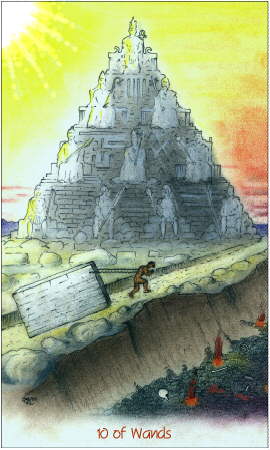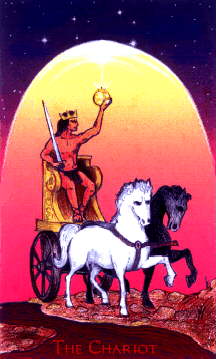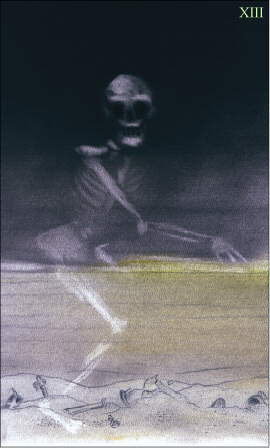 Maninni
II back design
Maninni
II back design
Completed: May 16, 1999
The design shows the "many little hands" of the Maninni, and incorporates signatures or logos of the contributors.
A group of tarot aficionados from the Tarot-L mailing list are creating a collaborative tarot deck, called Maninni II. You can see the other cards on Michele Jackson's Maninni II homepage (click the graphic at left). (The first Maninni deck was created in 1997, before I joined the list). I was assigned two cards: Death and the 10 of wands. I also volunteered to do a back design for the cards. To help with an eleventh-hour emergency, I also took in the Chariot card. The card images and descriptive text appear here.
 Ten
of Wands
Ten
of Wands
completed: January 31, 1999
media: pen, pastel, and colored pencil
The ten of wands represents the final manifestation of will in the material world. This is the point at which all the desires and plans are translated into the production of a physical artifact. Although this is the goal of the will, it is also the death of the will, for the accomplishment when completed is lifeless, no longer seeking anything. There is also the sobering recognition that shaping matter according to one's will involves labor and perhaps the exploitation of nature or of humanity.
The card is a variation on a familiar image: the building of the Egyptian pyramids. How many schoolbooks show the slaves hauling the massive blocks up the dusty ramp to create the great monument? The image is meant to convey both the enormity of the undertaking and to raise the moral, political, and religious implications of subjugating the population to indulge the vanity of the pharaoh.
The squad of laborers has been replaced by a single figure, pulling an impossible burden. The pyramid has become a stone hierarchy of ten wand-bearing figures of authority. The top of the pyramid catches the rays of the spiritual light, while the poor living soul labors in the gloom of its shadow. Social systems, designed to execute the will of the culture, become rigid, heavy, and oppressive with time. Although fossils, the lifeless stone figures continue to dominate and overpower their solitary living subject. Does he even see that he is helping to build the very structure that oppresses him?
Below him, to the right, is a vast pit in which the discarded byproducts of the great labor decay and smolder. The Biblical Gehenna was such a place. It is the negative counterpart of the towering monument, a reminder of the destruction that is implicit in every creation.
Keywords: toil, burden, feeling overwhelmed by work, trying to accomplish the impossible, oppression (personal and political), serving "the system", obedience to long-dead powers and ideas, doing the work while others receive the benefit, the ambivalent consequences of reshaping the world, patriarchal imperialism and its victims, creativity dying even as it becomes manifest.
 The
Chariot
The
Chariot
completed: May 31, 1999
media: pencil, computer graphics, and colored pencil
The Chariot card depicts the triumphant war god, returning to celebrate his victory and receive the cheers and adulation of the crowds. In this design, based on the Tarocco Siciliano, he rides an open chariot and holds aloft his orb of power. A change in vantage point from the traditional Tarot of Marseilles design allows us to more readily perceive his haughty indifference. He does not notice us at all, his gazed fixed intently on his goal.
The Chariot epitomizes machismo and bravado, the frighteningly aggressive warrior's ideal of glory. Basking in the fountain of his own light, the hero is insulated from the mysteries of the cosmos that he has yet to penetrate. The two horses represent the yin and yang principles; the perspective used in this design emphasizes the white horse; the black one appears almost to be its shadow. Likewise, the warrior hides his subconscious behind his active will. But the darkness creeps in around the edges: the night sky above his head, the dark river of blood below his feet.
We may fear his sword, we may lament his lack of compassion, but we cannot deny that the warrior god is an irreplaceable ally. He defends, he defeats oppression, he pursues his goal with courage, no matter what the odds. Whatever else he his, he is never a victim. Without him, nothing could be achieved; we would all lose heart, caught in a morass of ethical and philosophical contingencies at every turn. For the charioteer, the story is much plainer: I came, I saw, I conquered.
Numerologically, The Chariot (7) is related to The Tower (16), both cards of pride and ego; the first, at the apex of its glory, the second, at the nadir of its destruction. In the board game "Stratego", one remarkably effective strategy is to use one of the more powerful pieces to invade the enemy ranks and penetrate as deeply as possible, oblivious to the dangers. In the end, this is a suicide mission; the fearless warrior eventually meets his match and dies. But before that moment comes, the opposing forces can be utterly decimated by the onslaught. Boldness is eventually its own undoing, but it can leave an impressive trail of achievement in its wake.
Keywords: ambition, courage, male ego, boldness, determination, fighting injustice, asserting oneself, channeling anger into work, decisiveness, ignoring risks, achievement, success, fame, power, making history, overcoming obstacles, indifference to issues of ethics and compassion.
 Death
Death
completed: February 5, 1999
media: pastel and colored pencil
The first tarot decks were created in the wake of the Black Death, which had devastated Europe in waves for nearly a century. Today, we can hardly imagine the scale and terror of this epidemic, which left one out of every three people dead, moving from first symptoms to death in less than a week. It was capricious: in the same household, some would die and some would be untouched. Many felt sure the end of the world was at hand.
Death takes not just the poor and sick, but the wealthy and the pious. It is the great equalizer. The soul is stripped of all its trappings before passing through Death's portal. The familiar skeletal reaper appears everywhere in European art after the Black Death; it had become a constant companion in the consciousness of the culture. The minds of many must have been opened to the transience and futility of mortal existence.
Philosophers have speculated that the awareness of one's own mortality is the source of all true religion, perhaps even the driving force behind all human striving. We seldom acknowledge the fear of death, but it lives with each of us. What is the shape of the fear of death? I think it is the sense of being drawn rapidly, inescapably, toward an aperture through which we know we cannot pass. Death is when the inconceivable becomes the inevitable.
Mainstream modern tarot interpretation views Death in terms of transformation and rebirth. Perhaps finding a market in card readers reluctant to frighten their querents, Death itself is transformed and reborn in many a contemporary deck, sometimes even approaching cheerfulness. This card returns to a simpler, harsher motif. Perhaps sweeping away the litter collected in the sands of time, the reaper turns toward the viewer with recognition. Beyond lies a desert, unbroken and arid to the very horizon, which is lit by an eerie glow. What lies beyond Death? There, at the edge of infinity, lies the wordless answer.
This Death is vaporous and spectral. He corrodes all substances, but remains himself without substance and timeless, having no form other than that which we give him in our nightmares.
Keywords: fear of the unknown, awareness of mortality, facing an unimaginable change or circumstance, decay, entropy, loss, the boundary of the ego, the end of time, futility, a barrier to be penetrated.
|
Completed: May 16, 1999 The design shows the "many little hands" of the Maninni, and incorporates signatures or logos of the contributors. |
Return to Telperion Productions entry page
Copyright © 1999 Tom Tadfor Little